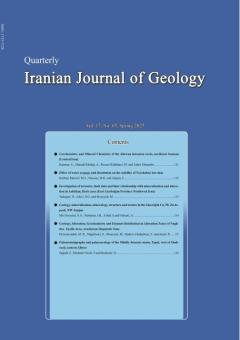نشت آب و تاثیر انحلال در پایداری سد بار نیشابور
الموضوعات :محمدتقی کرباسی معروف 1 , حميدرضا ناصري 2 , فرشاد علیجانی 3
1 - دانشگاه شهید بهشتی
2 - دانشگاه شهید بهشتی
3 - دانشگاه شهید بهشتی
الکلمات المفتاحية: انحلال ساخت¬گاه سد, سد بار, مدل¬سازی نشت ,
ملخص المقالة :
سد بار در شمال غرب شهر نیشابور و در خارج بستر رودخانه بار، با هدف تامین آب شرب شهر نیشابور و کارخانه فولاد ساخته شده است. بیلان آبی سد بار حکایت از وجود 35 تا حداکثر 70 درصد نشت آب از مخزن سد طی شش دوره آبگیری آزمایشی می کند. نشت قابل توجه و غلظت بالای املاح در آب نشت یافته، علاوه بر تاثیر بر برنامهریزی منابع آب و تخصیص های پیشبینی شده، تهدیدی برای پایداری سد محسوب می شود. تحلیل هیدروگراف چاه های مشاهدهای نشان از نشت عمده آب از بخش مرکزی پی ساختگاه سد اصلی و به میزان کمتر از سایر نواحی میکند. مدل سازی نشت آب با استفاده از نرم افزار MODFLOW نشان میدهد، 75 درصد حجم آب نشت یافته از پی ساخت گاه سد اصلی عبور می کند. تجزیه شیمیایی نمونه های آب نشت یافته از افزایش غلظت املاح به بیش از پنج تا 10 برابر، بخصوص در نواحی مرکزی و جناح چپ مخزن سد حکایت می کند. با تلفیق داده های مدل سازی نشت آب از مخزن سد، نتایج نمونه برداری های هیدروشیمیایی، تحلیل سری زمانی میزان نشت و بیلان جرمی آب مخزن سد، مقدار ماده انحلال یافته در اثر نشت آب از پی ساخت گاه سد اصلی محاسبه شده است. در نهایت تاثیر انحلال بر افزایش پوکی بررسی شد و نتایج نشان داد حداکثر توسعه سالانه پوکی در بخش میانی محور سد اصلی در حدود 06/0 درصد می باشد.
اکبری، ف.، باقری، ر. و ندری، آ.، 1397. بیلان هیدروژئولوژیک تالاب برم شور در شهرستان هفتکل استان خوزستان. فصلنامه زمینشناسی ایران، 12، 48، 1-10.
محمودلو، م.، جندقی، ن. و صیادی، م.، 1399. تکامل هیدروشیمیایی و کاهش کیفیت آب رودخانه گرگانرود. فصلنامه زمینشناسی ایران، 14، 55، 129-145.
نبی¬زاده، ن. و جعفری، ه. 1400. تخمین تغذیه آبخوان مرزی سرخس با استفاده از مدل عددی. فصلنامه زمینشناسی ایران، 15، 57، 15-27.
شرکت آبپوی.، 1394. گزارش مطالعات رفتارنگاری و آببندی مخزن سد بار. وزارت نیرو، شرکت آب منطقهای خراسان رضوی، 20.
واعظی، ع. و اسماعیل¬نیا، ن.، 1394. تعیین لایه نشتی و بررسی مکانیسم نشت از تکیهگاه چپ سد آغ چای (آذربایجان غربی) با استفاده از مطالعات هیدروژئولوژی. فصلنامه مهندسی آبیاری و آب، 8، 30.
Bedmar, A. P. and Araguas, L. U. I. S., 2002. Detection and the Prevention of Leaks from Dams. CRC Press.
Craft, C. D., Pearson, R. M. and Hurcomb, D., 2007. Mineral dissolution and dam seepage chemistry–The Bureau of reclamation experience. In Proceedings of the 2007 National Meeting, Dam Safety 2007.
-Jixiang, H.U., Fuheng, M.A. and Jiang, H.U., 2018. Characteristics and evolution of seepage water hydrochemistry at dam-site on Lijiaxia hydropower station. Congres des Grands Barrages, Vienne.
Kimble, J. M., Knox, E. G. and Holzhey, C. S., 1993. Soil survey laboratory methods for characterizing physical and chemical properties and mineralogy of soils. In Application of Agricultural Analysis in Environmental Studies, ASTM International.
Li, X. Ye, S., Wang, L. and Zhang, J., 2017. Tracing groundwater recharge sources beneath a reservoir on a mountain-front plain using hydrochemistry and stable isotopes. Water Science and Technology: Water Supply, 17(5), 1447-1457.
McDonald M.G. and Harbaugh A.W. 1988. A modular three-dimensional finite-difference groundwater flow model. U.S. Geological survey Techniques of Water-Resources Investigation 6(A1). 586.
Mozafari, M., Raeisi, E. and Guerrero, J., 2018. Contribution of spectral coherency analysis and tracer test to study leakage at the Doosti Dam reservoir. Iran and Turkmenistan Environmental earth sciences, 77(4), 139.
Noble, J. and Ansari, M. A., 2017. Environmental isotope investigation for the identification of source of springs observed in the hillock on the left flank of Gollaleru Earthen Dam, Andhra Pradesh, India. Journal of Earth System Science,126(5), 67.
Piqueras, J. M., Perez, E. S. and Menendez-Pidal, I., 2012. Water seepage beneath dams on soluble evaporite deposits: a laboratory and field study (Caspe Dam, Spain). Bulletin of engineering Geology and the Environment, 71(2), 201-213.
Sammen, S. S., Mohamed, T. A., Ghazali, A. H., Sidek, L. M. and El-Shafie, A., 2017. An evaluation of existent methods for estimation of embankment dam breach parameters. Natural Hazards, 87(1), 545-566.
Sjodahl, P., Dahlin, T. and Johansson, S., 2008. Resistivity monitoring for internal erosion detection at Hallby embankment dam. In Progress in Environmental and Engineering Geophysics: Proceedings of the International Conference on Environmental and Engineering Geophysics, International Conference on E-Commerce E-Business and E-Government (ICEEG) Science Press, 310-316.
Ullah, A., Kassim, A., Alam, I. and Junaid, M., 2019 Efficiency analysis of seepage of Baz Ali small dam, Kurram Agency using clay blanket and cut off wall with sand filter, Journal of the Geological Society of Malaysia, 67, 113-118.
Unal, B., Celik, M. and Yıldırım, T., 2008. Evaluation of seepage problems of the Armagan Dam, Kırklareli, northwestern Turkey. Bulletin of Engineering Geology and the Environment, 67(3), 335-344.
Wang, S.W., Xu, Y.L., Gu, C.S. and Bao, T.F., 2018. Monitoring models for base flow effect and daily variation of dam seepage elements considering time lag effect. Water Science and Engineering, 11(4), 344-354.


